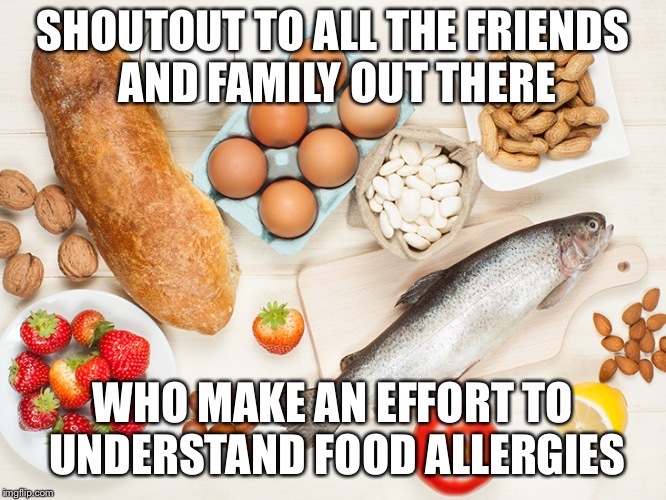If you’ve been following GFS, you’re likely aware that my sister has Irritable Bowel Syndrome. Due to her diagnosis, she cannot have gluten, dairy, or soy. You can read more about why I started GFS here.
I posted recently about May being Celiac Awareness Month and someone told me that they had never heard of Celiac. I’ve written before about invisible illnesses and the myths and misconceptions about food sensitivities and allergies. This comment got me thinking about what else people may not understand about food allergies and sensitivities. Since I have several family members with IBS, I’m more familiar with it and it’s day-to-day effects. I am knowledgeable about Celiac and other food sensitivities and allergies, but I’m always learning more.
I decided to write an overview related to food sensitivities and allergies. This is by no means an exhaustive explanation. It is more of a CliffNotes guide to help those who aren’t affected have more awareness.

[bctt tweet=”An overview of food sensitivities and allergies” username=”gfspirit”]
Food Sensitivities vs Food Allergies
This is the most basic thing to understand. According to Very Well Health, a food sensitivity is “when you have a food intolerance, symptoms are milder than those you would have with a food allergy. In addition, your symptoms will not be immediate, and are not life-threatening. They tend to be mainly digestive in nature (bloating, diarrhea or constipation, stomach cramps, and gas), and may not surface for up to several days after you consume the offending food.”
FARE defines food allergy as “a serious and potentially life-threatening medical condition affecting 32 million Americans. One in every 13 children has a food allergy—that’s about 2 in every U.S. classroom. And every 3 minutes, a food allergy reaction sends someone to the emergency room.”
The top 8 most common allergens in the US are milk (dairy), eggs, soy, wheat/gluten, peanuts, tree nuts, fish, and shellfish. Other food allergens include casein, corn, meat, fruit and veggies, sesame, spice, seed, and gelatin.

Celiac Disease
Celiac disease (or Coeliac in the UK) is an autoimmune disease in which the person can’t consume gluten because it will damage their small intestine.
According to Celiac.org, when someone with celiac eats gluten, the body attacks the small intestine and damages the villi. The villi supports nutrition absorption. When damaged, the villi can’t properly support nutrient absorption.
If Celiac disease is left untreated, it can lead to a myriad of health problems such as Type I Diabetes, Multiple Sclerosis, seizures, migraines, and rashes among others.

Gluten
We hear about gluten a lot these days. Many foods claim to be gluten-free, usually for food marketing for those who think it’s a fad or trendy. In reality, this couldn’t be further from the truth.
Gluten is the general term for proteins found in wheat, barley, and rye. Gluten helps food to retain their shape.

Irritable Bowel Syndrome vs Irritable Bowel Disease
The Crohns & Colitis Foundation of America says “inflammatory bowel diseases are a group of inflammatory conditions in which the body’s own immune system attacks parts of the digestive system. The two most common inflammatory bowel diseases are Crohn’s disease (CD) and ulcerative colitis (UC).”
The foundation goes on to describe IBS as the following: “Irritable bowel syndrome is a condition that affects the function and behavior of the intestines. Normally, the muscles lining the intestines intermittently contract and relax to move food along the digestive tract. In IBS, this pattern is disturbed, resulting in uncomfortable symptoms.”

As I said at the beginning, this is a CliffNotes version to give you a general idea of what these food sensitivities and allergies are. Knowledge is power and even the most basic information can help you to understand better. When you can better understand something, you’re more likely to become empathetic to those that deal with these diagnoses every day.

As always, sharing is charing. If you found this CliffNotes guide helpful, please share with others that might benefit. Follow GFS on social media using the buttons below for the most up-to-date information. Get my blogposts sent to your inbox by signing up for my mailing list.

Fortunately I don’t suffer from such problems but I imagine that doing so means finding alternatives just as tasty!
There’s been some trial & error, but my sister has found some good alternatives.
Your memes omg i died!!! I love how you simplified all these conditions, this is amazing. Thanks a lot.
I’m glad you enjoyed the memes because I thought they were funny. 😀 I wanted to try to make it easier for people to understand & remember.
Glad to learn about Gluten free and food allergies. A great lesson for me.
I’m glad you found it helpful! 🙂
Y just watched a recent documentary that covered food allergies. It totally opened my eyes to the difficulties that people with food allergies experience on a daily basis. Thank you for shining more light on this topic. Also, your memes are hilarious!
What documentary was it? I’m glad you found this helpful. I’m glad you found the memes to be as funny as I did! 😀
Thank you for the article. Many people just accept them not feeling bad. It’s nice to know that there may be a cause for it.
I agree. More people should pay attention to what their bodies are trying to tell them.
i am so lucky that i don’t suffer with food intolerances but I know those that do and it is a real effort to manage
It truly is. I didn’t realize just how much until I had firsthand experience with my sister.
Thank you for the detailed explanations as I do have friends suffering from these and sometimes wonder what is the difference between each allergies or intolerance.
You’re welcome! I’m glad to know that you found this helpful. 🙂